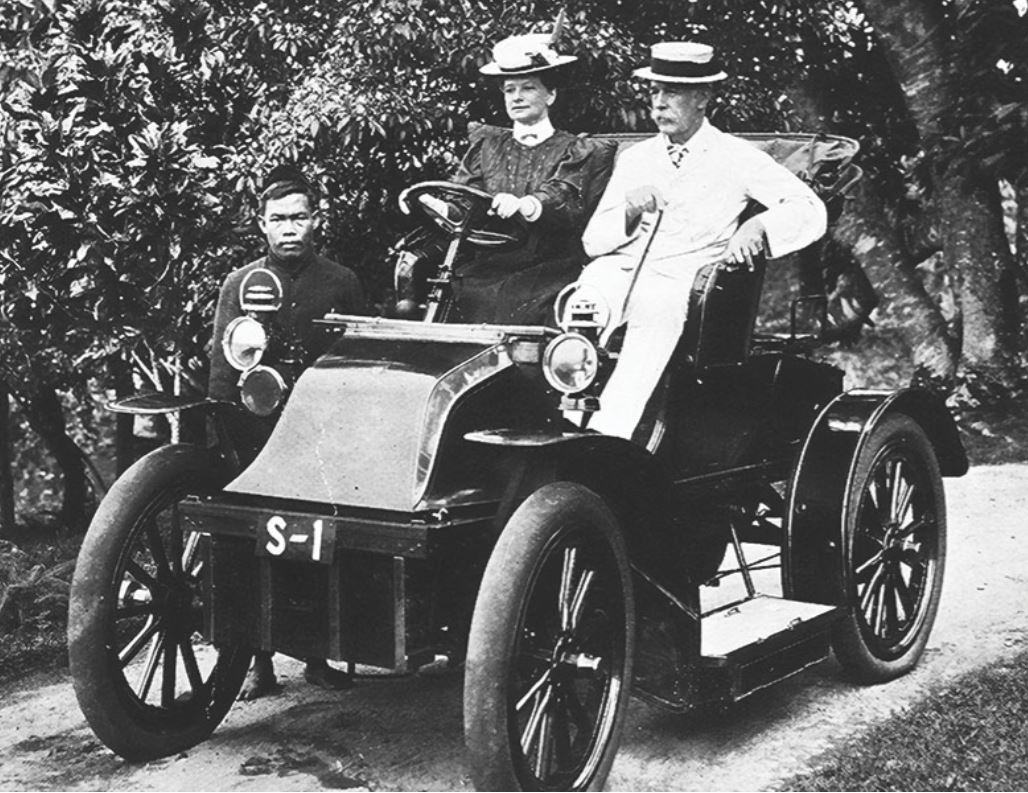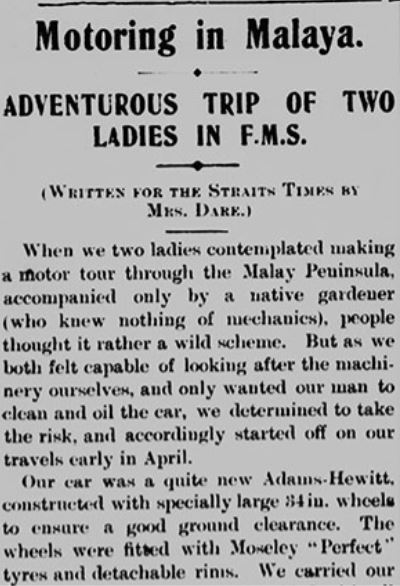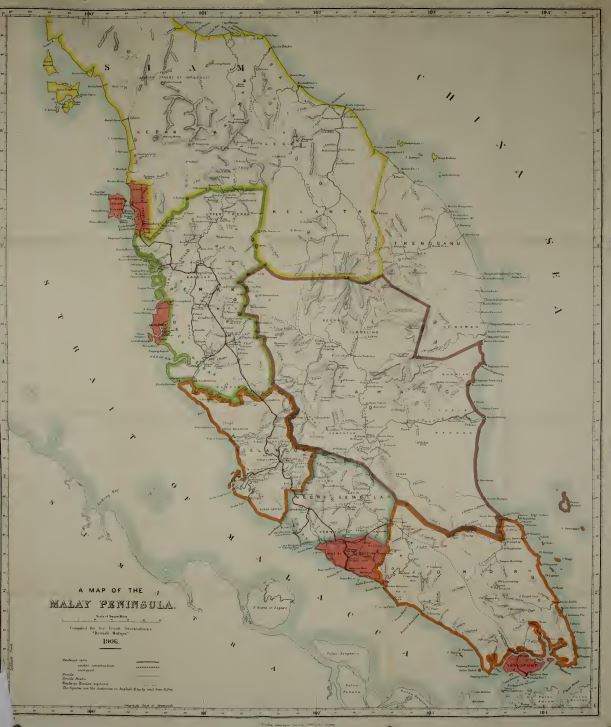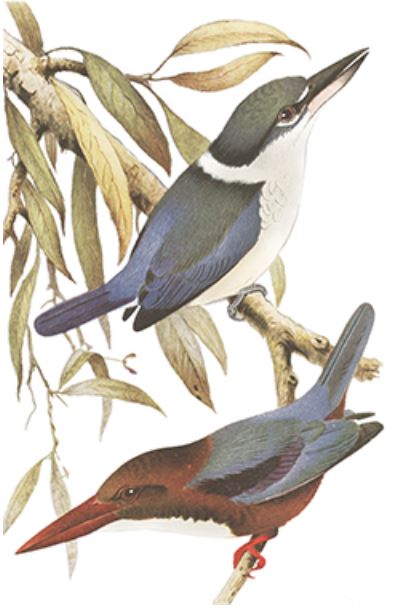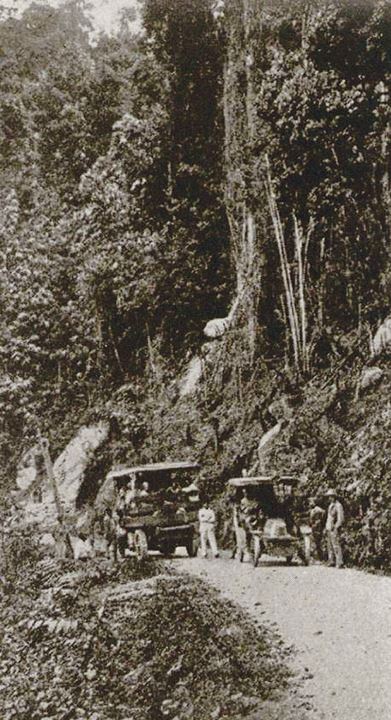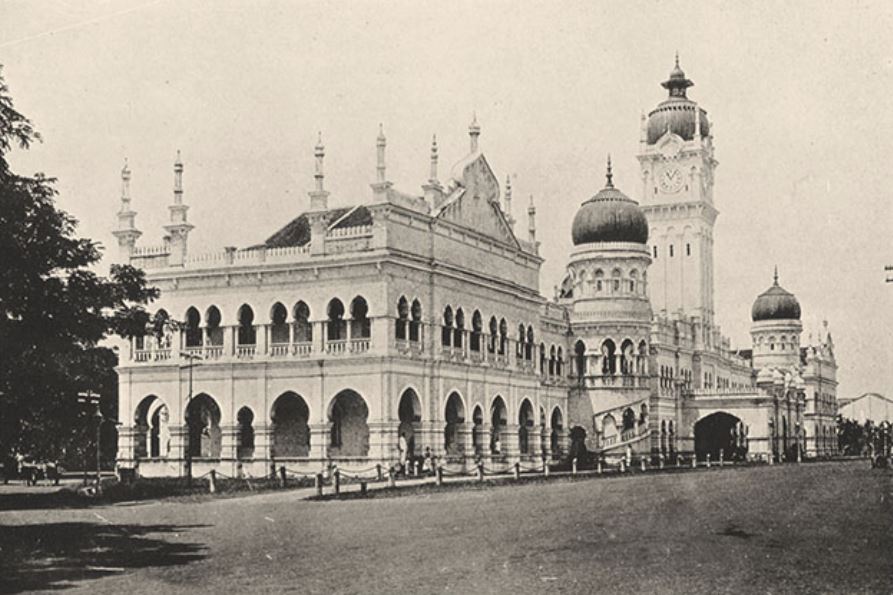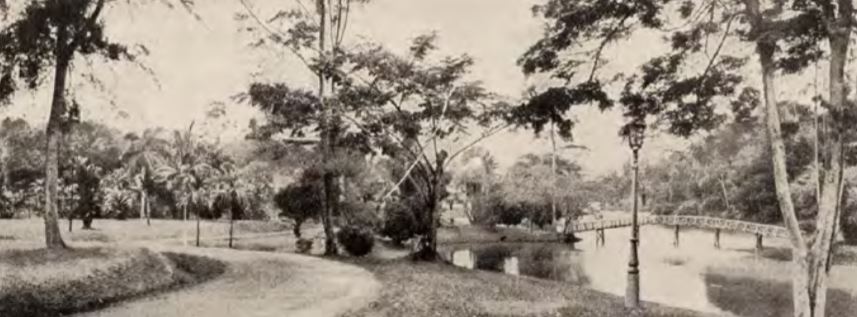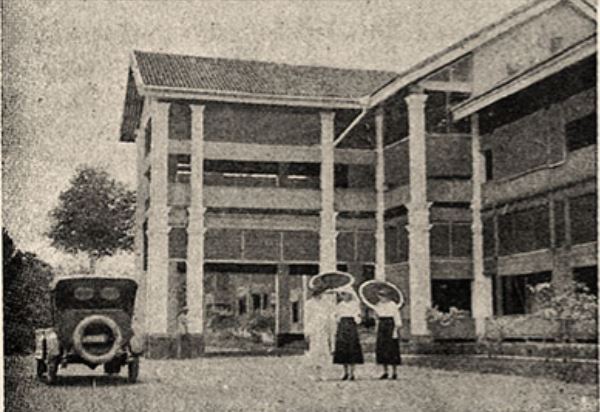Mrs Dare and Her Magnificent Driving Machine
The intrepid Mrs G.M. Dare – true to her name – was Singapore’s first woman driver. In April 1907, she embarked on a 686-mile road trip across the Malay Peninsula.
Cars were a relatively new mode of transportation in Singapore then (the first automobiles made their appearance here only a decade earlier in 1896) and Mrs Dare soon became a novel sight on the roads. Locals were amazed and fearful by turns to see her at the wheel and soon took to calling her car the “Devil Wind Carriage”.
Not content with driving on Singapore’s roads, Mrs Dare decided to embark on a driving expedition across the Malay Peninsula. On 15 April 1907, accompanied by her friend, Miss Hardman, and her Malay gardener, she took off from Penang, where the journey began, in her Adams-Hewitt. Both the car and its occupants had arrived a few days earlier by steamer from Singapore.
Mrs Dare’s driving adventure created quite a stir in the press and she took to writing about it. Her articles were published as “Motoring in Malaya: Adventurous Trip of Two Ladies in F.M.S” in *The Straits Times* over three days on 18 June, 19 June and 20 June 1907. The following is an abridged account of her 686-mile road trip across the Malay Peninsula.
When we two ladies contemplated making a motor tour through the Malay Peninsula, accompanied only by a native gardener (who knew nothing of mechanics), people thought it rather a wild scheme. But as we both felt capable of looking after the machinery ourselves, and only wanted our man to clean and oil the car, we were determined to take the risk. We started off on our travels in April 1907.
Our car was a quite new Adams-Hewitt, constructed with especially large 34-inch wheels to ensure a good ground clearance. The wheels were fitted with Moseley “Perfect” tyres and detachable rims. We carried our baggage with us, and were provided with all necessary spares as well as one outer cover and two inner tubes in a waterproof case. These were never used; although we crossed many patches of unrolled granite and sharp marble road metal, we never suffered from a single puncture and rarely had to pump up the tyres. Our car was named “Ichiban” (Japanese for “Number One”), as it bears the registered number S-1.
Starting from Penang
Having decided to start our trip from Penang, we planned to ship ourselves and Ichiban by the steamer Perak for the settlement. As the Perak could not dock at the wharf in Singapore, poor Ichiban had a bad start being transported to the steamer. It happened to be low tide in the Singapore River, so she had to be pushed down three flights of steep stone steps onto a series of uneven planks of different lengths and full of nails, and into a tongkong [sic], a Chinese cargo boat, at an angle of 45 degrees. The strain on the brakes and frame was very severe, and how the tyres stood the pinches and drops between the planks was a marvel. Fortunately, Ichiban escaped with only a bent mudguard and a broken oilcap.
Penang is 395 miles north of Singapore. On arrival, we discovered that the steamer would not call at the wharf in Penang until the next day. As a repetition of the tongkong experience was not desirable, we left our faithful gardener on board to guard the car while we spent the day and night up the hill at Crag Hotel, at an elevation of 2,400 feet, where the temperature is cool and the views magnificent.
Returning the next afternoon, we were lucky enough to meet the genial secretary of the Straits Automobile Association, who gave us valuable assistance in landing our car, and we were soon driving smoothly off the wharf to the Eastern & Oriental Hotel.
We spent several days in Penang and made some delightful excursions on the roads about the island. One particularly lovely drive was along the coast of Batu Ferringhi, and then inland beyond Teluk Bahang and up a mountain pass into Pahang. After repeated delays caused by the steamer’s defective water tank, we finally left Penang by the 3.26 pm steam ferry bound for Prai in Province Wellesley.
Flabbergasted Natives
On reaching the mainland, we screwed on the milometer and embarked on our 34-mile run to Bagan Serai in Perak. There are many good roads in this district such that it is easy to take a wrong turn – and we did it twice! We found it exceedingly difficult to get reliable directions. The natives were so flabbergasted at the spectacle of a lady driving a “devil wind carriage” that they were quite incapable of answering our questions, and the only correct information we obtained was either from the Chinese or sharp little Kling boys.
However, we got on the right track at last, and after crossing the Krian river on a pontoon bridge, and passing through Parit Buntar, we eventually reached Bagan Serai Resthouse at 7 pm. Our first thought was to see how many miles we had done, but alas the milometer was gone! We informed the police of our loss, hoping that someone might have picked it up. We had very little hope of recovering it, not having a notion where it had been lost, but to our great joy, a constable came round to the resthouse at 9.30 pm to say that the milometer had been found at Sempang Lima – five miles back.
Taiping and the Larut Hills
Bagan Serai Resthouse is not at all a bad place with an upper storey, but if it were only kept clean! The rooms were thick with dust and the furniture broken. The beds, however, were clean, and the dinner quite good.
In the morning, we drove back for the milometer – which was quite uninjured but the journey delayed us somewhat – and headed for Taiping 26 miles away. Six miles beyond Bagan Serai, the Kuran river is crossed by a small pontoon boat, which is hauled across the stream by a wire rope. Two planks were laid each side to bridge the intervening space of water from the pontoon to the boat, and we drove over these on board, the planks being carried with us to be utilised in the same manner on the other side.
From this point, the road began to ascend, and we crossed the Semangol Pass, which at 1,279 ft affords a glorious vista of the wooded Larut Hills and the grand mountain ranges of Perak. The road surface was excellent, and a pleasant spin through flat, open country past many deserted tin mines took us into Taiping by 9.30 am, quite ready for the excellent breakfast provided for us by the kind friends with whom we stayed.
Taiping is prettily situated on a flat plain, backed by the Larut Hills (3,600 to 7,000 ft). There is a picturesque lake in the Public Gardens, a good racecourse, rifle range and cricket ground, and two excellent clubs. The well-stocked museum contains the best collection of old Malay krisses and knives in the Federated Malay States.
There are also several bungalows on the Larut Hills belonging to the government as well as private individuals. English flowers and vegetables thrive up there and the temperature is cool enough to make a nice fire at night. The Resident of Perak E.W. Birch kindly placed the bungalow named “The Box” at our disposal and we spent a day and night up there, revelling in a perfect wilderness of lovely roses, heliotrope, lilies, geraniums, azaleas and all sorts of English flowers, in addition to varieties of tropical blooms.
From “The Box” at 4,200 ft, the views are immense. Below, Taiping looks like a tiny map and the roads (being of white limestone and marble) show out distinctly, as was the very straight line of railway to the coast of Port Weld. To the right, in the distance, is the island of Penang and to the left the group of islands called the Dindings; on a clear day, the opposite high mountains of Sumatra are faintly visible.
Inland, one looks into the heart of the Malay Peninsula. Range upon range of mountains from 4,000 to 9,000 feet, nearly all untouched and unscaled by man – primeval jungle – the happy hunting ground of tigers, elephants, deer, wild pig, bears, monkeys and what not!
We returned to Taiping and motored out to the 18th milestone on the Kuala Kangsar road where, at the Penghulu’s, we were provided with an elephant, on which we rode for two miles. On arrival at the cool shady riverside, we found a shed erected and a delicious tiffin of Malay curries for our benefit. It was great fun watching the Malays and the men of our party seated on thick pieces of plantain fibre called upih and tobogganing down some 60 feet of smooth rock in the river into the cool inviting pool below – an activity called menggelunchor.
(Right) Menggelunchor involves sitting on thick pieces of plantain fibre called upih and tobogganing down the smooth rock in the river into the pool below. Mrs Dare was treated to such a scene in Taiping.
Bound for Ipoh
We left Taiping for Ipoh via Kuala Kangsar, a distance of 56 miles, at 8.30 am on 20 April, and had a delightful run over the Bukit Larut Pass. The morning was exceptionally clear and the mountains a magnificent sight. Right in front of us was Gunong Pondok, a huge perpendicular pinnacle of limestone rock.
Kuala Kangsar is the former capital of Perak, and the sultan lives in a fine palace on the banks of the broad river. We proceeded along the upper road, which leads through the official portion of the town past the hospital, barracks and various government offices to the Malay College, where we breakfasted with friends. Then, taking riskshas, we visited the School of Art and the new Residency situated on a wooded knoll. After tiffin, we left Kuala Kangsar immediately so as to arrive in Ipoh in time for tea and to escape the usual afternoon rain squall.
Crossing Perak River
At Enggor we drove across Perak River on a rickety bridge of boats, and proceeded without mishap along the smooth undulating road through well-wooded country until we reached the tin-mining town of Sungei Siput.
There, we were alarmed by a fearful clattering in the car, and were relieved to find that it was caused by nothing worse than the top section of the chain-guard having somehow caught in the number plate! It was of no real consequence but it meant a vexatious delay as the whole cover had come off and a piece cut out. A Chinese tinsmith’s shop was close by, but no offers of money would induce him to lend us his metal-cutting scissors, or to come and work himself unless the car was taken to his shop, which was obviously impossible, as there was no road! So we set to work and cut away the metal with two pairs of wire-cutters, a long and tedious job, made doubly difficult by the large crowd of rude Chinese coolies who had surrounded us by then but offered no assistance. After three quarters of an hour’s delay, we continued our journey.
More Obstacles on the Road
A few miles further on it began to pour in torrents, necessitating another half an hour’s stoppage under the trees with the apron up, till the rain moderated a bit and we proceeded another few miles; then to be once more held up by a couple of huge tree trunks that had fallen right across the road. The second of these had been sawn in pieces, and could be pushed out of the way, but the first one was immovable!
As we were only nine miles from our destination, it seemed ridiculous to go back all the way to Kuala Kangsar, so we were determined to bridge the obstacle. We and our Malay attendant pulled up some planks from the wayside benches, laid them in position so as to form an inclined gangway from the road to the top of the prostrate trunk, and covered the uneven ends of the planks with bits of bark. Some natives helped to push the car over and after an hour and a half’s delay, Ichiban was again on the move. Half a mile on, another and yet larger tree blocked the way but here the government coolies were already at work sawing it up, so half an hour more saw us again spinning along, and enjoying the now fine evening and beautiful sunset.
We had, however, only covered another mile when a fourth large tree obstructed us. It was getting dark and the road was lonely. A bullock cart laden with split logs was parked behind it, with the Sikh driver fast asleep beneath. We were now so accustomed to climbing trees that we soon had the contents of the cart piled on each side of the tree in a sort of sloping bridge and while two of us looked on, the third drove the car over triumphantly!
Ichiban took it like a bird, but the toolbox under the step caught on the logs and was wrenched off, the contents spilling out; thankfully the step itself was uninjured. We picked up the tools and the debris, and packed everything away as neatly as possible and were off again, ultimately reaching the Residency at Ipoh without more misfortunes. We felt that quite enough for one day had fallen to our lot, and congratulated ourselves on having surmounted all with so little damage to Ichiban.
Ipoh and Beyond
Ipoh is a large and flourishing town in the centre of the tin mining district. There are also interesting marble works, the whole country being full of huge limestone and marble rocks. Even the milestones are made of white marble! We stayed two days for repairs, thoroughly appreciating the rest in this most comfortable and prettily situated Residency, the garden extending to the edge of the Kinta River.
We left Ipoh on 22 April at 8 am for our longest run of 98 miles to Tanjong Malim. The road to Gopeng is more hilly but it has an excellent surface and the scenery is very pretty. We stopped en route at Sungei Raya to look at a curious five-storeyed Chinese temple built inside some limestone caves. At Gopeng, the road diverges along a high ridge on which are situated the District Officer’s house and a nice resthouse with an upper storey and broad verandah. The resthouse commands a fine view over the town and adjoining mining country, backed by ranges of limestone cliff.
The rest of the road to Tapah was equally smooth, and we ran up a very steep hill to the resthouse where we tiffined. At 2 pm, we started on our remaining 58 miles to Tanjong Malim, and arrived at 7 pm. The road is very winding and too overgrown to travel at any great speed, although the surface is smooth and made of red laterite. From Bidor, the road goes through the thickest jungle, and here we spotted jungle cocks, blue pheasants, brilliant blue flycatchers and kingfishers as well as colourful butterflies. We ran over two snakes and saw a huge black scorpion about nine inches long! Two strong-smelling musangs (civet cats) ran across the road at different times, and in one place a very distinct scent of tiger was apparent – it is not a place one would care to spend the night in, should one’s car break down!
The resthouse at Tanjong Malim is very comfortable and the food good. We found our supply of petrol waiting for us here, sent from Kuala Lumpur by the Federated Engineering Company.
We left the next morning at nine, and covered the 17 miles of charming road to Kuala Kubu in an hour. After calling at the post office to pick up our mail, we turned up the road to the Semangko Pass, at 2,700 ft. The gradient is very easy and the splendidly made road winds up and through magnificent jungle, every turn revealing some new beauty. Being the only road into Pahang at present, we encountered much bullock cart traffic. Almost every turn we encountered two or three bullock carts, but as they are accustomed to the Motor Mail Service, the bullocks themselves move to the proper side of the road the moment they hear the horn, even when their drivers have fallen asleep!
About one-third of the way up, a horrible grating noise proceeding from the interior of the car greatly alarmed us, but we could not locate it and thought the noise was due to an insufficiency of oil in the gear box. In addition to this awful din, our new water tank began to leak badly so we went up very slowly, stopping at every stream or waterfall to fill up the tank and cool down the overheated engine. On arriving at the Gap (the boundary between Selangor and Pahang) at 2.40 pm, we decided to stay there for the night.
The next morning, after giving the gear box a good dose of oil, we started on our 15-mile-run downhill to Tras, and thence for eight miles on to Raub, the water tank having to be filled at every available opportunity. Whilst tiffining at Raub Resthouse, the car was left at the local garage to have the tank resoldered. The manager there informed us that special riveted tanks should be used in this climate. We had only travelled eight miles out of Raub when the tank began to leak worse than ever! This time, the solder at the junction of the waterpipe and radiator had given way. We bound it up as well as we could with rubber tubing and wire, and by dint of constantly refilling we eventually arrived in Kuala Lipis at 7 pm, making a total of 62 miles for the day.
After crossing the Lipis River, the road skirted its bank for a good part of the way. Kuala Lipis is pleasingly situated at the junction of the Lipis and Jellei rivers, after which they join and become the main Pahang river, the sole route to the east coast from the interior – a trip of over 200 miles. We stayed two days at the Residency, the walls of which are made entirely of plaited palm leaves, in white and brown.
Raub to Kuala Lumpur
The manager of the Motor Service kindly took our radiator in to Raub to have the pipe properly fixed and brought it back the next morning. The same afternoon we left on our return journey, only doing the 39 miles into Raub, where we spent a most comfortable night in the resthouse. We left Raub the next day at 10.30 am, the car going up the Semangko Pass quite nicely this time. After a rest and cool down at the Gap, we started off again at 2.45 pm, and ran down the hill to Kuala Kubu in two hours – 50 miles in all during the day – a countryfied spot on the banks of a river.
We left on 28 April at 11 am for Kuala Lumpur – a run of 38 miles – but it took us the best part of the day as the wretched tank again leaked like a sieve and we had to stop every two or three miles to replenish the water. The road was somewhat more stony and hilly in places. We passed a great many alluvial tin mines with their armies of Chinese coolies. Seven miles from Kuala Lumpur we passed the famous caves at Batu, and from there a fine broad road goes into the capital of Selangor.
Kuala Lumpur
The capital has a large European population, with well-built bungalows, churches, hospitals, government offices, a town club, a country club and the Public Gardens with a fine large lake.
The Resident General, W. Taylor, with whom we stayed, has a beautiful house up on the hill overlooking the lake and gardens. In fact, the place is very hilly, each house standing on its own separate eminence. There are many motorcars here, and the big engineering works belongs to the Federated Engineering Company, so we had Ichiban thoroughly overhauled during our four-day visit.
We left on 2 May for Dusun Tua – 17 miles of charming road through very pretty scenery. The day was perfect and the car going beautifully, so we did not hurry. It is impossible to drive right up to the resthouse now, the old bridge having been replaced by a narrow and high iron suspension bridge, but on this side of the river there is an iron roofed shed, big enough to shelter two motorcars, and a little beyond, stabling and syces’ quarters. Ichiban was deposited in the shelter, and our baggage carried up to the resthouse. Not having telegraphed beforehand, we did not expect to get anything solid to eat till dinner time, and were going to order tea. But some other person who had ordered a tiffin had not turned up, so we instead ate it thankfully!
The resthouse is beautifully clean and the attendants most obliging, especially a cook who made delicious cakes for tea. The hot sulphur baths are delightful; the water is led into big bath tanks direct from the natural spring, which bubbles up at a temperature of 162 degrees Fahrenheit.
After tea, we had a stroll up the road for a couple of miles, and saw a few huts or shelters, much like fowl houses, and caught sight of some figures inside, but really did not see any Sakeis (aborigines) properly. The following day at 10.30 am, we left for Seremban, a distance of 44 miles, and had a delightful run to Kajang, Semenyih and Beranang – the roads were very good but as soon as we passed the frontier into Negri Sembilan, they became stony and full of ruts. Moreover, many of the bridges were being re-made, so we had to cross rough little structures at the side of the road.
All went well until after we had passed Mantin and were well up the pass to Setul. There we were stopped by two fallen trees right across the road. As these trees must have been about 150 feet long and thick in proportion, it would have taken days before they are removed. So we were thankful when the government coolies arrived and cut away the bank on the hillside and widened the road sufficiently for our car to crawl underneath, with her hood taken off completely and the driver’s head well bent down. It really was great fun, in spite of the hour-and-a-half’s delay! Several carts, with their kadjang (screw pine) roofs removed, and two dog-carts also got safely through. After this, we met with no more adventures, and the rest of the road was in good order right into Seremban, which we reached at 2.40 pm.
Seremban and on to Singapore
Seremban, the capital of Negri Sembilan, is a good-sized town prettily situated on hilly ground and backed by ranges of fine mountains. A great deal of tin is brought in here for export by rail to Port Dickson on the coast, and thence by steamer to Singapore. There are boxes, vases, trays, frames, and all sorts of quaint Chinese things manufactured in solid tin and fancifully engraved. It is as bright as silver and only requires polishing with a hard brush to keep bright.
Kind friends again hospitably entertained us for a couple of days and then we continued our journey to Malacca by the Remban road, a distance of 60 miles. An excellent surface and shady road greeted us, and we passed through well-grown rubber plantations and finely wooded hills. We drove leisurely as it was so cool and pleasant, and reached Tampin (33 miles) by 12.30 pm.
After a pleasant little tiffin with the District Officer Mr Flemming, we continued at 3 pm and crossed the boundary into Malacca territory. The road became execrable as far as Alor Gajah and turned into a series of mud holes. On nearing Malacca, there was a distinct improvement and we were able to quicken the pace a bit. We drove all the way to Tanjong Kling by the excellent coast road, before staying a week with the Resident Councillor and his wife. Meanwhile, Ichiban was sent by train to Port Swettenham and shipped from there in the steamer Selangor.
We boarded the Selangor in Malacca and reached Singapore on 13 May, after a most enjoyable trip of 686 miles.
She passed away from an illness on 28 January 1927 and her remains were laid to rest at Bidadari Cemetery.
References
Death of Mrs. G.P. Owen. (1927, January 29). The Straits Times, p. 9. Retrieved from NewspaperSG.
Ladies motoring in the Malay Peninsula. (1907, May 9) The Singapore Free Press, p. 6. Retrieved from NewspaperSG.
Ladies motoring in the Malay Peninsula. (1907, May 11). The Singapore Free Press, p. 12. Retrieved from NewspaperSG.
Makepeace, W., Brooke, G.E., & Braddell, R.S.J. (Eds.). (1991). One hundred years of Singapore (Vol. 2, p. 364). Singapore: Oxford University Press. (Call no.: RSING 959.57 ONE-[HIS])
Monday, April 8, 1907. (1907, April 11). The Singapore Free Press, p. 232. Retrieved from NewspaperSG.
Motoring in Malaya: Adventurous trip of two ladies in F.M.S. (1907, June 18). The Straits Times, p. 11. Retrieved from NewspaperSG.
Motoring in Malaya: Adventurous trip of two ladies in F.M.S. (1907, June 19). The Straits Times, p. 11. Retrieved from NewspaperSG.
Motoring in Malaya: Adventurous trip of two ladies in F.M.S. (1907, June 2). The Straits Times, p. 11. Retrieved from NewspaperSG.
The late Mr. George Mildmay Dare. (1907, December 16). The Singapore Free Press, p. 5. Retrieved from NewspaperSG.


